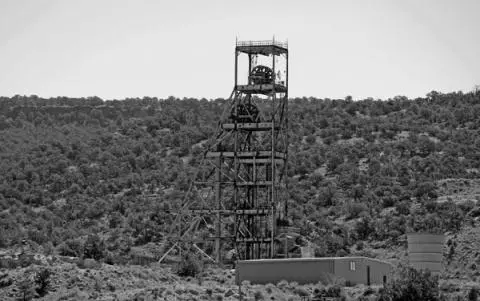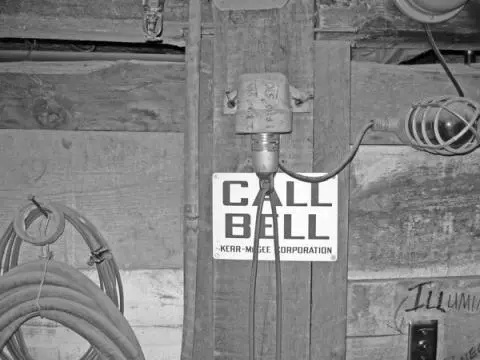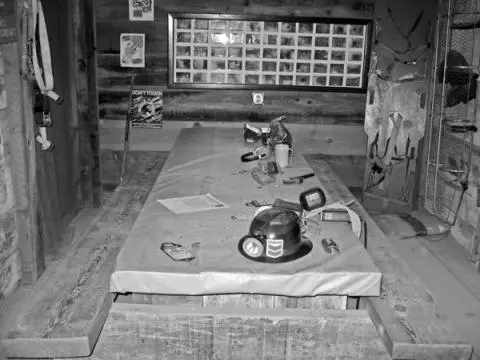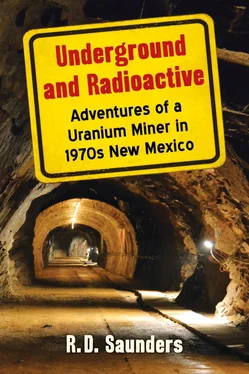I knew some hoist operators, and they were very well trained and highly skilled. Most of the lifting and lowering was done blind by bell signals sent by mine personnel, either by the cage area or underground, to the operator in the hoist room.
The cage is akin to an elevator car in that it carries people up and down a vertical shaft but with a much more industrial, utilitarian appearance. It really did look similar to a cage, being made of metal bars and angle iron. It had a metal grate floor and a sliding door that looked something like a jail cell door. The cage held probably fifteen to twenty workers tightly packed, true to its name, when I rode in one I felt caged in.
I don’t like crowds much, so I never enjoyed the cage, but it was the only way into and out of the mine.
It was a helpless feeling standing there in the cage having no control whatsoever, dependent upon the skill of the hoist operator. I always hoped that things were going well at home, that he had slept well and was in a good mood. Needless to say, that wasn’t always the case.
There were many times during a ride down into the mine that the hoist operator would drop us twenty or thirty feet before recovering. Always a nice surprise. Those drops were quite the ride and elicited some colorful discussion among those on the cage concerning the hoist operator. I suspect the drops were sometimes not accidental but couldn’t prove it. More than once drops were so severe that individual miners made it a point to get in touch with the hoist operator after a shift change, and a not-so-pleasant exchange ensued. Fortunately, the ride down was usually a nice, smooth descent.
The drops and other cage experiences were all in the future. For now, I was just standing out there, all shiny and new, with the other men waiting for a ride down to the 1–5 level.
A lot was going through my mind then, but I never doubted that when I stepped off that cage for the first time, I’d be accepted into the subterranean fraternity of miners, motormen, welders, engineers, geologists, and others, or in my case laborers.
I was looking forward to learning all about mining and working with a lot of people who were earning a tough and honest living. I was much more concerned about being able to do the actual heavy physical labor than I was about getting along with my coworkers or being confined in the relatively small working areas of a mine.

Headframe of the type common to most mines in the Ambrosia Lake area. Large wheels are visible on the second and third deck over which cable runs back to a hoist room where it is spooled on large motorized drums. One set is for raising and lowering people and supplies and the other is for lifting ore out of the mine (photograph by R.D. Saunders).
I think I deferred to just about everyone before I stepped onto the cage for the first time until those left waiting were myself and a few relatively new guys.
We did finally step into the cage for the ride down to the 1–5 level at about eight hundred feet. One of the men knew the bell signals, and off we went. It was a great ride, as I remember, as I was excited and full of anticipation, and thankfully we weren’t dropped.
I came to know a number of people who stepped off the cage, took a look around, did an about-face, got back on, and were never seen underground again. Most often they ended up working at a support job on the surface, driving a truck or loader, stocking supplies, or something similar. And quite the contrary to what I’d heard in orientation, some miners had at least a degree of contempt for these individuals. I wasn’t one of them. I knew there were a lot of jobs I wouldn’t or couldn’t do myself, and whatever the equivalent to stepping off a cage is in those jobs, I would have gotten back on and gone back up myself.

Call bell at the station used to signal the hoist operator on the surface. The sequence of the bell pulls indicated to the hoist operator whether those on the cage wanted to go up or down and to what level of the mine they were headed. I used this system so frequently that I can still use it from memory (photograph by R.D. Saunders from an exhibit courtesy New Mexico Mining Museum).
As time went on, I came to feel sorry for the surface guys—that they weren’t able to savor the grand ecstasy of the absolute blackness of the underground, the muffled (or sometimes not) explosions, and the unique smells. It was their loss that they never got the opportunity to expand their vocabulary through working relationships with miners from all over the world willing and able to teach obscenities in a dozen different languages.

The 1–5 level station. There was nothing fancy about life underground, as the signage illustrates (photograph by R.D. Saunders from an exhibit courtesy of the New Mexico Mining Museum).
The cage came to a stop on the 1–5 level at an area called the station. The station is one of the few very well-lit areas underground and is large by mine standards, being maybe fifty by fifty feet with a ceiling of twelve or more feet high.
Stepping off the cage, I noticed right away that the walls were lined with wire-mesh fencing material that was bolted on. I soon learned that walls are called “ribs” and the ceiling the “back.” The bolts are simply called bolts, or rock bolts specifically, and work on the same principal as plastic expanders used with screws to fasten objects to Sheetrock walls.
All kinds of supplies were stacked in the station: large stacks of timber, rock bolts, wire mesh, and everything else used underground. I would soon learn the specifics of those supplies I now saw all piled up there in the station.
I played follow-the-leader as our group headed to the lunchroom. The lunchroom is another fairly large cutout into the rib, large enough for a twelve-foot picnic-type table and a small lectern used for announcements. It was more or less the bosses’ station and office. There was a sign-in and sign-out board, a blasting board, and various rescue equipment leaning against the walls.
The walls were covered with maps and diagrams of the 1–5 level. I’d say the roof was about eight feet or so. It was quite a comfortable place, really, and one where everyone gathered before shift, for lunch, and after shift. When the bosses weren’t wandering around checking on their crews, it’s where they spent a lot of time.
I had no trouble finding Frankie who was prominently seated at the bosses’ station. Frankie was another well-experienced former miner converted to shift boss either by choice or necessity. By his countenance he wore every bit of his experience. To me this guy looked just like what I imagined a miner might look like. I have to say I felt silly standing there before him in my shiny new outfit.
Unfortunately, it quickly became apparent that Frankie had been through my personnel file and knew where I’d been and how I’d come to show up there in front of him. It didn’t appear he’d been much impressed with what he’d seen.
He probably said hello, but I don’t remember hearing it. What I do recall is he immediately began his personal Section 35, 1–5 level orientation session.

Underground lunchroom. In addition to the lunch hour, workers gathered here before and after their shifts when bosses would relay announcements and reminders that were usually safety related. It was one of the more comfortable and safe areas of the mine. In the right hand corner are a rescue board and basket used to transport injured workers.

Bosses’ station in the lunchroom. If they weren’t wandering around the mine, bosses could usually be found here. The lens cleaning station was where mine workers could clean their safety glasses. Because they fogged up easily and otherwise got in the way, very few workers wore them on a regular basis (photograph by R.D. Saunders from an exhibit courtesy New Mexico Mining Museum).
“Now, I don’t take no bullshit. You get here on time and ready to go every day, and you work with who I tell you. You don’t know how to do anything, but we’ll fix that. You’ll be getting the shit jobs, and don’t complain because I don’t give a fuck.”
Читать дальше

















